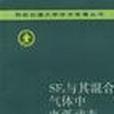《SF6與其混合氣體中電弧動態特性和套用》是1997年西安交通大學出版社出版的圖書,作者是王其平等。
基本介紹
- 作者:王其平 / 等
- ISBN:9787560508917
- 頁數:240
- 定價:14.00
- 出版社:西安交通大學出版社
- 出版時間:1997-03
- 裝幀:平裝
內容介紹,作者介紹,作品目錄,
內容介紹
內容簡介
本書系統地總結了作者十多年來在SF6與其混合氣體中電弧動態特性
的研究成果。書中第1至5章,全面敘述SF6與其混合氣體的基本特性和有
關實驗研究。第6至9章著重介紹創新建立的電弧二維動態數學模型和所采
用的數值分析方法及其套用。第10至14章,深入分析SF6與其混合氣體中
電弧熱邊界區特性和電弧阻塞現象,並系統地研究其氣流特性。最後兩章敘
述滅弧室結構參數的綜合調整,以改善混合氣體滅弧室的開斷特性,為在斷
路器中套用SF6/N2混合氣體取代純SF6提供了科學依據。
本書不僅對分析SF6和SF6/N2混合氣體電弧特性有理論意義,並且對
SF6和SF6/N2混合氣體斷路器的研製開發具有實用價值。
本書可供高等學校、研究和設計製造單位有關專業的教師、研究生、科學
研究人員和工程技術人員參考套用。
A BRIEF INTRODUCTION TO THE BOOK
The systematical results of the authors' researches on dynamic charac-
teristics of electric arcs in SF6 and its gas mixtures are summed up in this
book. From Ist to 5th chapters, the fundamental properties of SF6 and its
gas mixtures and experimental researches concerned are comprehensively re-
lated. From 6th to 9th chapters, a new two-dimensional mathematical model
of arc and its numerical analyses and applications are presented. From lOth
to 14th chapters, characterictics of thermal bounday region of arc and phe-
nomena of arc clogging in SF6 and its gas mixtures are analyzed. In the last
two chapters the comprehensive adjustments of construction parameters of
the interrupter are introduced in order to improve the breaking characteris-
tics of the interrupter with SF6/N2 gas mixtures.
This book is an academic monograph and applies to teachers, postgrad-
uates, researches and engineers of relevant specialities of universities, re-
search and design institutes.
作者介紹
作者簡介
王其平教授,浙江寧波人,1926
年出生於上海。1949年畢業於上海
大同大學。50年代曾在蘇聯莫斯科
動力學院進修研究。1952年1月起
歷任上海交通大學、西安交通大學助
教、講師、副教授、教授、博士生導師。
現任西安交通大學學術委員會副主
任,《西安交通大學學報》主編,校人
體科學研究中心主任,電力設備電氣
絕緣國家重點實驗室學術委員會主
席,中國電工技術學會名譽理事,電
接觸及電弧研究會主任委員,跨國
IEEE高級會員,國際氣體放電及其套用會議國際委員會委員等
職。
40多年來,王其平教授一直從事電器和電弧理論、電接觸理
論的教學和科學研究工作,是交通大學電器專業創建人之一。早在
1963年出版的《電器中的電弧理論》一書,為國內這方面第一本專
著,在創建電器電弧理論的科學體系方面起了先導和開拓作用。
王其平教授與其合作者在國內首先創建了四個不同層次、各
具特色的電弧動態數學模型,提出了電接觸材料的侵蝕機理和表
面形貌特徵的新觀點。出版了5部專著,發表論文120餘篇,獲國
家教育委員會、機械電子工業部頒發的科技進步獎5項和榮譽證
書10多種,還獲得國務院1991年頒發的政府特殊津貼證書。
他與同事聯合發起和主持了在西安交通大學召開的兩屆“電
接觸、電弧、電器及其套用國際會議”,應邀訪問過瑞士、德、英、意、
波、加、日、美等國的有關大學。
他是我國在該領域內有突出貢獻的專家,被選入1992年出版
的《中國人名大詞典》當代人物卷。
A Brief Introduction of the Author
Wang Qi-Ping was born in 1926 in Shanghai, China. He
graduated from DaTong University, Shanghai in 1949. He
engaged in advanced studies in Moscow Power Engineering
Institute, in 1950s. He is a dishtinguished professor of Xi'an
Jiaotong University. He also served as the Vice President of
the Academic Committee of the university, Chief Editor of
the Journal of Xi'an Jiaotong University, Director of Somatic
Science Research Center of the university, Chairman of the
Academic committee of State Key Laboratory of Electrical
Insulation for Power Equipments, Honoary Council Member
of China Electrotechnical Society, Chairman of Electric
Contact and Arc Research Institute, senior member of IEEE,
member of International Committee of International Conference
on Gas Discharges and Their Applications, etc..
For more than forty years, Prof. Wang Qi-Ping has been
engaged in teaching and research of electrical apparatus, electric
arc theory and contact theory. He was one of the founders of
Electrical Apparatus Speciality of Jiaotong University. The book
"The Theory of Electric Arcs in Electrical Apparatus" was pub-
lished early in 1963, it is the first book on this field in China.
Prof. Wang and his cooporators established four different kinds
of mathematical models of electric arc in gas flow with distinctive
features for the first time in China, and advanced the new view-
points of the formation mechanisms of erosion and surface mor-
phology of electric contacts by breaking arcs. He has published
five books and more than 120 papers in the above mentioned
fields. His scientific research work is fruitful. He has obtained
five awards of science and technology progress and more than 10
honorable certificates given by the State Education Commission
and Ministry of Machine Building and Electronic Industry, and
the certificate for special allowance given by State Council in
1991.
He with his colleagues jointly sponsored and organized Ist
and 2nd International Conference on Electrical Arcs, Contacts,
Apparatus and their Applications in Xi'an. He was invited to interna-
tional conference many times and was invited to visit relevant u-
niversities in more than 23 countries: Switzerland, Germany, U. K. ,
Italy, Poland,Canada, Japan, U.S.A and etc.
Prof. Wang is a specialist with distinguished contributions
in electrical engineering. His name and biography has been in-
cluded in "The Great Dictionary of Chinese Biography-Contem-
porary Figures" published in 1992.
作品目錄
目錄
前言
符號說明
第1章 緒論
1.1 SF6氣體的特性和SF6滅弧室工作原理
1.2 SF6混合氣體滅弧性能研究的進展
1.3 電弧動態特性和數學模型的研究
第2章 SF6混合氣體基本性質及選擇
2.1 混合氣體理論
2.2 添加氣體的物理化學性質
2.3 SF6混合氣體的物理化學性質
2.4 SF6混合氣體的選擇
第3章 SF6和SF6/N2氣體中電弧參數的測試及分析
3.1 實驗設備
3.2 電弧電壓、電流和燃弧時間的測試
3.3 電位探針法對弧柱電位梯度的測試
3.4 電弧弧柱形象的拍攝
3.5 電弧電漿溫度的光譜診斷
3.6 SF6與SF6/N2氣體中電弧參數的比較
第4章 SF6和SF6/N2氣體存在電弧時氣流場的光學
顯示測量
4.1 光學測量的基本原理
4.2 差分干涉測量技術及光路布置
4.3 電弧氣流場的測量方法和特點
4.4 干涉條紋間距的確定及條紋方向的影響
4.5 電弧氣流場光學顯示測量結果
第5章 SF6和SF6/N2氣體滅弧室開斷特性的實驗研究
5.1 實驗設備與測試技術
5.2 開斷電流過程中滅弧室氣壓和分閘速度分析
5.3 SF6和SF6/N2氣體滅弧室開斷特性的實驗結果
5.4 噴口直徑和混合比對開斷特性的影響
5.5 混合氣體開斷特性分析
5.6 混合氣體開斷特性的經驗公式
第6章 電弧二維動態數學模型
6.1 本研究所用的滅弧室結構
6.2 電弧二維動態數學模型的控制方程組
6.3 關於湍流的考慮
6.4 對於輻射的處理
6.5 電弧二維動態數學模型的建立
6.6 本電弧數學模型的特點
第7章 數值分析方法
7.1 Patankar-Spalding方法簡介
7.2 Patankar-Spalding方法在噴口電弧上的套用
7.3 流場中固體區域的處理
7.4 壁面函式法
7.5 關於弧柱邊界
7.6 電腦程式
第8章 SF6和SF6/N2氣體中噴口電弧特性的數值分析
8.1 SF6和SF6/N2氣體中電弧的準穩態特性
8.2 SF6和SF6/N2氣體中電弧的動態特性
8.3 SF6和SF6/N2氣體中電弧電流過零後的熱恢復特性
第9章 SF6和SF6/N2氣體介質強度恢復特性的數值分析
9.1 滅弧室靜電場的數值分析
9.2 弧後氣流場的計算
9.3 SF6和SF6/N2氣體介質強度恢復特性
第10章 電弧熱邊界區特性及分析
10.1 電弧弧柱、熱邊界區和外部冷氣流的組成
10.2 熱邊界區的形成過程和變化特點
10.3 熱邊界區直徑和溫度
10.4 熱邊界區對噴口氣流量和電弧能量發散的影響
10.5 熱邊界區對介質強度恢復特性的影響
第11章 SF6和SF6/N2氣體中電弧阻塞效應分析
11.1 電弧阻塞效應概述
11.2 弧柱阻塞與熱邊界區阻塞
11.3 電弧能量密度的影響
11.4 流量密度和焓流率的影響
11.5 氣體性質與加熱效應的關係
11.6 SF6/N2混合氣體中電弧阻塞效應的增強
第12章 SF6和SF6/N2氣體氣流特性的數值分析
12.1 滅弧室噴口內氣流動態特性的分析原理
12.2 噴口中電弧能量分布及其對氣流的影響
12.3 上游氣缸內氣體能量平衡方程
12.4 噴口內氣流量方程
12.5 氣流特性與分閘速度特性的聯合模擬計算
12.6 數值分析原理與計算
第13章 SF6和SF6/N2氣體氣流特性研究
13.1 SF6/N2混合氣體熱力學參數的求解
13.2 SF6、N2和SF6/N2氣體氣流特性的數值計算結果
13.3 不同氣體介質對分閘速度的影響
13.4 混合比、充氣壓力及機構操作力對氣流特性的影響
第14章 滅弧室噴口內氣流場參數的空間分布
14.1 一維定常等熵流理論
14.2 噴口內氣流流動狀態與激波位置判定
14.3 滅弧室噴口內不存在激波的條件
14.4 滅弧室噴口內氣流場參數的數值計算結果
第15章 滅弧室結構參數對SF6/N2混合氣體開斷特性
的影響
15.1 壓氣式變熄弧距滅弧室的主要結構形式和參數
15.2 氣缸直徑的影響
15.3 噴口喉部直徑的影響
15.4 上游區長度的影響及lu/Dt比值的確定
15.5 噴口下游擴張角的影響
第16章 混合氣體滅弧室開斷特性改善與結構參數
的選擇最佳化
16.1 氣流特性改善的依據和目的
16.2 混合比、充氣壓力與操動機構操作力的確定
16.3 滅弧室結構參數的綜合調整
參考文獻
前言
符號說明
第1章 緒論
1.1 SF6氣體的特性和SF6滅弧室工作原理
1.2 SF6混合氣體滅弧性能研究的進展
1.3 電弧動態特性和數學模型的研究
第2章 SF6混合氣體基本性質及選擇
2.1 混合氣體理論
2.2 添加氣體的物理化學性質
2.3 SF6混合氣體的物理化學性質
2.4 SF6混合氣體的選擇
第3章 SF6和SF6/N2氣體中電弧參數的測試及分析
3.1 實驗設備
3.2 電弧電壓、電流和燃弧時間的測試
3.3 電位探針法對弧柱電位梯度的測試
3.4 電弧弧柱形象的拍攝
3.5 電弧電漿溫度的光譜診斷
3.6 SF6與SF6/N2氣體中電弧參數的比較
第4章 SF6和SF6/N2氣體存在電弧時氣流場的光學
顯示測量
4.1 光學測量的基本原理
4.2 差分干涉測量技術及光路布置
4.3 電弧氣流場的測量方法和特點
4.4 干涉條紋間距的確定及條紋方向的影響
4.5 電弧氣流場光學顯示測量結果
第5章 SF6和SF6/N2氣體滅弧室開斷特性的實驗研究
5.1 實驗設備與測試技術
5.2 開斷電流過程中滅弧室氣壓和分閘速度分析
5.3 SF6和SF6/N2氣體滅弧室開斷特性的實驗結果
5.4 噴口直徑和混合比對開斷特性的影響
5.5 混合氣體開斷特性分析
5.6 混合氣體開斷特性的經驗公式
第6章 電弧二維動態數學模型
6.1 本研究所用的滅弧室結構
6.2 電弧二維動態數學模型的控制方程組
6.3 關於湍流的考慮
6.4 對於輻射的處理
6.5 電弧二維動態數學模型的建立
6.6 本電弧數學模型的特點
第7章 數值分析方法
7.1 Patankar-Spalding方法簡介
7.2 Patankar-Spalding方法在噴口電弧上的套用
7.3 流場中固體區域的處理
7.4 壁面函式法
7.5 關於弧柱邊界
7.6 電腦程式
第8章 SF6和SF6/N2氣體中噴口電弧特性的數值分析
8.1 SF6和SF6/N2氣體中電弧的準穩態特性
8.2 SF6和SF6/N2氣體中電弧的動態特性
8.3 SF6和SF6/N2氣體中電弧電流過零後的熱恢復特性
第9章 SF6和SF6/N2氣體介質強度恢復特性的數值分析
9.1 滅弧室靜電場的數值分析
9.2 弧後氣流場的計算
9.3 SF6和SF6/N2氣體介質強度恢復特性
第10章 電弧熱邊界區特性及分析
10.1 電弧弧柱、熱邊界區和外部冷氣流的組成
10.2 熱邊界區的形成過程和變化特點
10.3 熱邊界區直徑和溫度
10.4 熱邊界區對噴口氣流量和電弧能量發散的影響
10.5 熱邊界區對介質強度恢復特性的影響
第11章 SF6和SF6/N2氣體中電弧阻塞效應分析
11.1 電弧阻塞效應概述
11.2 弧柱阻塞與熱邊界區阻塞
11.3 電弧能量密度的影響
11.4 流量密度和焓流率的影響
11.5 氣體性質與加熱效應的關係
11.6 SF6/N2混合氣體中電弧阻塞效應的增強
第12章 SF6和SF6/N2氣體氣流特性的數值分析
12.1 滅弧室噴口內氣流動態特性的分析原理
12.2 噴口中電弧能量分布及其對氣流的影響
12.3 上游氣缸內氣體能量平衡方程
12.4 噴口內氣流量方程
12.5 氣流特性與分閘速度特性的聯合模擬計算
12.6 數值分析原理與計算
第13章 SF6和SF6/N2氣體氣流特性研究
13.1 SF6/N2混合氣體熱力學參數的求解
13.2 SF6、N2和SF6/N2氣體氣流特性的數值計算結果
13.3 不同氣體介質對分閘速度的影響
13.4 混合比、充氣壓力及機構操作力對氣流特性的影響
第14章 滅弧室噴口內氣流場參數的空間分布
14.1 一維定常等熵流理論
14.2 噴口內氣流流動狀態與激波位置判定
14.3 滅弧室噴口內不存在激波的條件
14.4 滅弧室噴口內氣流場參數的數值計算結果
第15章 滅弧室結構參數對SF6/N2混合氣體開斷特性
的影響
15.1 壓氣式變熄弧距滅弧室的主要結構形式和參數
15.2 氣缸直徑的影響
15.3 噴口喉部直徑的影響
15.4 上游區長度的影響及lu/Dt比值的確定
15.5 噴口下游擴張角的影響
第16章 混合氣體滅弧室開斷特性改善與結構參數
的選擇最佳化
16.1 氣流特性改善的依據和目的
16.2 混合比、充氣壓力與操動機構操作力的確定
16.3 滅弧室結構參數的綜合調整
參考文獻

